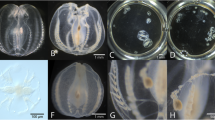Abstract
In enumerating data for systematic and ecological studies on meiofauna, an unfortunate diversification exists in the methods used for observation, identification, preservation and curatorial treatment of various taxa. The application of transmission electron microscopy resin embedment techniques to whole, quantitative, extracted meiofauna samples is described here as a new method, which overcomes most of these problems. Slide-shaped resin blocks are produced by this method; they contain the mass-embedded meiofauna on one side and sand from the sample site on the other side; the latter can be used in studying sand-grain epigrowth of Protista, Fungi and Monera. Examples for the applicability of these slides to various meiobenthic studies are given for most taxa, but especially for Turbellaria, Annelida and Mystacocarida. Using this resin-slide technique, whole quantitative transects can be deposited as “ecotype material” in museums.
Similar content being viewed by others
Literature Cited
Cavey, M.J. and R.A. Cloney: Osmium-fixed and epon-embedded whole mounts of delicate specimens. Trans. Am. microsc. Soc. 92, 148–151 (1973)
Elmgren, R.: Methods of sampling sublittoral soft bottom meiofauna. Oikos (Suppl.) 15, 112–120 (1973)
Gray, J.G.: Sample size and sample frequency in relation to the quantitative sampling of sand meiofauna. Smithson. Contr. Zool. 76, 191–198 (1971)
Hall, J.R.: Aspects of the biology of Derocheilocaris typica (Crustacea: Mystacocarida). II. Distribution. Mar. Biol. 12, 42–52 (1972)
— and R.R. Hessler: Aspects in the population dynamics of Derocheilocaris typica (Mystacocarida, Crustacea). Vie Milieu 22, 305–326 (1971)
Heip, C., N. Smol and W. Hautekiet: A rapid method of extracting meiobenthic nematodes and copepods from mud and detritus. Mar. Biol. 28, 79–81 (1974)
Hessler, R.R.: A new species of Mystacocarida from Maine. Vie Milieu 20, 105–116 (1969)
Hulings, N.C. and J.S. Gray: A manual for the study of meiofauna. Smithson. Contr. Zool. 76, 1–83 (1971)
Luft, J.H.: Improvements in epoxy resin embedding methods. J. biophys. biochem. Cytol. 9, 409–414 (1961)
Meadows, P.S. and J.G. Anderson: Micro-organisms attached to marine sand grains. J. mar. biol. Ass. U.K. 48, 161–175 (1968)
Ores, R.O.: Advantages of epoxy resin as a mounting medium for light microscopy. Stain Technol. 46, 315–317 (1971)
Renaud-Mornant, J. et C. Delamare Deboutteville: L'originalité de la sous-classe des Mystacocarides (Crustacea) et le problème de leur répartition. Ann. Spéléol. 31, 75–83 (1976)
Rieger, R.M.: Multiple ciliary structures in developing spermatozoa of marine Catenulida (Turbellaria). Zoomorphologie 89, (1978)
— and G.E. Rieger: Fine structure of the pharyngeal bulb in Trilobodrilus and its phylogenetic significance within Archiannelida. Tissue Cell 7, 267–279 (1975)
—, E. Ruppert, G.E. Rieger and C. Schoepfer-Sterrer: On the fine structure of gastrotrichs with description of Chordodasys antennatus sp. n. Zoologica Scr. 3, 219–237 (1974)
Ruppert, E.E.: An efficient, quantitative method for sampling the meiobenthos. Limnol. Oceanogr. 17, 629–631 (1972)
Sterrer, W.: Plate tectonics as a mechanism for dispersal and speciation in interstitial sand fauna. Neth. J. Sea Res. 7, 200–222 (1973)
Thiel, H., D. Thistle and G.D. Wilson: Ultrasonic treatment of sediment samples for more efficient sorting of meiofauna. Limnol. Oceanogr. 20, 472–473 (1975)
Uhlig, G., H. Thiel and J.S. Gray: The quantitative separation of meiofauna. Helgoländer wiss. Meeresunters. 25, 173–195 (1973)
Westheide, W.: Monographie der Gattungen Hesionides Friedrich und Microphthalmus Mecznikow (Polychaeta, Hesionidae). Z. Morph. Tiere 61, 1–159 (1967)
— The geographical distribution of intertidal polychaetes. Mikrofauna Meeresbod. 61, 281–296 (1977)
Winborn, W.B. and D.L. Guerrero: The use of a single tissue specimen for both transmission and scanning electron microscopy. Cytobios 10, 83–91 (1974)
Author information
Authors and Affiliations
Additional information
Commnicated by M.R. Tripp, Newark
Rights and permissions
About this article
Cite this article
Rieger, R.M., Ruppert, E. Resin embedments of quantitative meiofauna samples for ecological and structural studies — Description and application. Mar. Biol. 46, 223–235 (1978). https://doi.org/10.1007/BF00390684
Accepted:
Issue Date:
DOI: https://doi.org/10.1007/BF00390684




